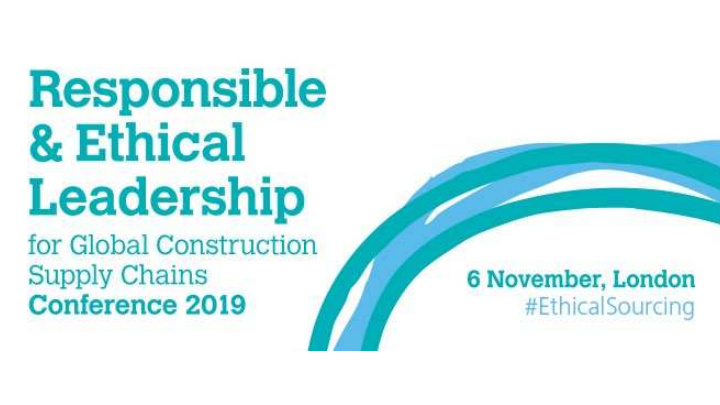



Stuart Wright Group Property and Facilities Director Aviva Plc
Dr Shamir Ghumra, BREEAM Director BRE
Jim McClelland McClelland Media
www.slido.com #ethicalsourcing What is your understanding of Ethical Sourcing? Where 10 = I am an expert and 1 = I know nothing
The Modern Slavery Construction Challenge… Chris Harrop OBE
https://www.modernslaveryregistry.org/
https://www.supplychainmovement.com/
Corporate Corporate Corporate Witness Perpetrator Victim
Katherine Brickell Professor of Human Geography Royal Holloway, University of London (Presentation will not be shared)
Q&A Data and Research
Jaya Chakrabarti MBE TISCReport (Presentation will not be shared)
Q&A Transparency
In Conversation Professor Charles Egbu, President, CIOB and Baroness Lola Young of Hornsey OBE
Traceability Professor Adrian Henriques, Middlesex University, UK
What is ‘traceability’? • Traceability is the history of specific items • Formal definition – ISO 9001 (2015): ‘ability to trace the history, application or location of that which is under consideration’
How do we stop this happening?
Benefits of traceability • Underpin quality – problem solving and correction • Demonstrate value chain compliance – increasing regulation; address scandals • Reassure consumers – increasing public interest in ethics and health issues • Underpin the security of supply – valuable materials; volatile supply chains • Support corporate sustainability claims – for example about participation in the circular economy
What traceability is not • Transparency • Chain of custody • Supply chain mapping, typically covers: • General pattern of purchasing (not path taken by an individual item) by country • Main suppliers for particular products
Defining Chain of Custody & traceability • ‘chain of custody’ and ‘traceability’ are often confused – they are different! • Chain of custody: • Procedures for guardianship of items in supply chain • Aim: ensuring that certain characteristics (physical, environmental or social) of the material are protected – nothing enters or leaves the chain that shouldn’t • Defined at level of particular characteristics – eg % recycled, % iron, etc • Traceability: • The ability to find out where an item is or has been in the supply chain • Aim: knowing where things are and were • Defined at tangible level of items – eg crates of tools, piece of timber, etc • Traceability is not confined to the supply chain
CoC models Book & Claim Mass Balance Controlled Blending Segregated Identity Preserved
• Third largest retailer in the world – drug stores, food, electrical items, etc • Analysis of ingredients of some global brands products – eg skin lotion • May have 20-30 ingredients • Some are sensitive – eg organic, sourced Current from sensitive areas • Findings: practice - • Do not always have reliable data for WBA products • Supply chains are dynamic • Significant gaps in knowledge of traceability of key ingredients
• Siemens Rail Automation involved in very large rail projects in UK – CrossRail, Thameslink • Required by their customer to undertake supply Current chain analysis • Attempted to trace cable supply chain practice - • Suppliers only engaged with the project reluctantly Siemens • Could track some items back to mine – eg copper
• Rolls Royce engine parts: • Air safety a driver • Laser-etched with unique identifier • Can be traced in real time 24 hours a day • Pharmaceuticals: • Strict systems for identifying and tracing individual drug packages Current • Safety a driver • Food: practice • Varies, but generally high • Food safety a driver • In some cases possible to trace individual packages of tomatoes back to the row in the field in which they were grown
Status of traceability • Standardisation currently fragmentary • Different approaches in different industries • Some industries have very good, proprietary systems in place • No way to assess how much traceability is in place in a given supply chain See: Traceability: towards a history of everything https://files.bregroup.com/downloads/103062_BRE_Traceability_report.pdf
Framework for assessing traceability • 3 key aspects • Scope • Robustness • Level • What we need to know: • Location • Ownership • Guardianship • Transformation • Application
Routemap What do you know What do you know What do you know about your supply about your demand about your product ? chain? chain? What do you need to know for commercial and sustainability purposes? What do you need to disclose? Chain of Custody Traceability systems systems
Future Directions? • Will traceability be supported by the creation of ‘digital twins’? • Will traceability systems be made more secure through the implementation of blockchains? • Will real time traceability become normal through 5G networks?
Prospects for traceability • A framework is needed to underpin responsibility for sustainability • Hard to get the necessary information • The rewards are great in terms of: • Reputation • Commercial security
Q&A Traceability
In Conversation Dave Knight, Sustainability Advisor CARES and
CARES Traceability system • All CARES steels are 100% traceable at a batch and product level to the original steel producer. Traceability starts with a unique cast number. Molten steel is cast, rolled, and then delivered to the fabricator. During cutting or bending the cast number is accompanied by a ‘bar schedule reference’ and ‘bar mark’ before delivery and use. Batches of product will carry the labels shown.
OECD DUE DILIGENCE GUIDANCE FOR RESPONSIBLE BUSINESS CONDUCT, 2018
Transformation of the steel and construction sectors
Dr Shamir Ghumra BREEAM Director BRE
Q&A Disclosure
Recommend
More recommend